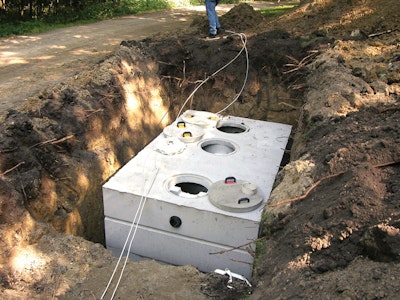Interested in Systems/ATUs?
Get Systems/ATUs articles, news and videos right in your inbox! Sign up now.
Systems/ATUs + Get AlertsThis continues our series on selection, location and installation of septic tanks. When we think of septic tanks, we include tanks of similar geometry and design that are used in front of other pretreatment units, so this includes trash tanks and processing tanks.
Last month we provided definitions and descriptions of these kinds of sewage tanks. Now, let’s look at septic tanks in more detail.
Septic tanks allow the separation of solids from wastewater as heavier solids settle and the fats, greases and lighter solids float. In a properly functioning septic tank, the solids content of the wastewater is reduced by 60 to 80 percent. The settled solids are called sludge, the floating solids are called scum, and in between is a relatively clear liquid layer called the clear zone. This liquid is not highly treated, but it is greatly clarified, and the treatment process has begun.
The right detention time
The second important function of a septic tank is to store the accumulated solids. So, one of the first considerations in design is to have a tank large enough to hold the solids until the tank is pumped. The goal is to have at least two days of detention time in the tank.
Detention time is determined by the tank volume divided by the daily sewage flow. So detention time for a 1,000-gallon tank with a daily sewage flow of 450 gpd is 1,000 gallons divided by 450 gpd, or 2.2 days — more than the desired two days.
Realize that as solids accumulate in the tank, the effective detention time is reduced. So, adhering strictly to the desired detention time as the tank fills would mean increasing the tank volume. For design purposes this is not typically done, but it can be desirable to have somewhat more tank capacity, and if the homeowner is willing to pay a little more for the insurance of more storage capacity, it is better to install a larger-capacity tank.
Levels of treatment
The treatment seen in a well-functioning septic tank should be such that effluent is in the range of 140 to 220 mg/l biochemical oxygen demand (BOD), 45 to 70 mg/l total suspended solids (TSS), and 10 to 30 mg/l fats, oil and grease (FOG).
If the effluent exceeds 175 mg/l BOD, 60 mg/l TSS or 25 mg/l FOG, the tank needs to be pumped. Or, if the reason the effluent is not treated to these levels is that the strength of the influent wastewater is too high, then additional pretreatment measures need to be taken, such as increasing tank capacity or adding an aerobic treatment unit (ATU) or media filter.
The anaerobic (without oxygen) digestion processes in septic tanks are affected by temperature (treatment is better when the tank is warmer) and by the addition of substances that adversely affect microorganisms in the tank. For example, chemicals, drain cleaners, antibiotics, and water softener backwash all can hinder treatment effectiveness.
Dealing with disposals
Two other major items that affect proper sizing of septic tanks are the use of a garbage disposal and the use of a grinder pump or solids-handling pump in the basement or at a lower level than the tank. In both cases, tank capacity must increase. The usual recommendation is to increase capacity by at least 50 percent, or 1.5 times what the design capacity would be without these features.
Use of a garbage disposal adds solids — often materials that are difficult to break down in the tank. That requires more frequent pumping. Water is also added when the disposal runs.
More capacity is needed with a grinder or solids pump because of the turbulence created by the pumping of water into the tank. Additional requirements for systems with the disposals or sump pumps include using a two-compartment tank or multiple tanks to provide the necessary capacity. Effluent screens with alarms are now usually required to further ensure that solids are not lost out of the tanks to the final soil dispersal area.
When working with homeowners who want to have a garbage disposal, it is a good idea to educate them about their responsibility for proper care of the system. You can place the discussion in the context of how their habits will affect the costs of installation and operation.
For single-compartment septic tanks, the depth, the length-to-width ratio, and the location of the baffles contribute to the time for solids to settle and be stored. There are usually depth restrictions — typically no more than 84 inches, and 36 inches is preferred.
An ideal length-to-width ratio is 3:1, though most tanks are not built that way. The normal ratio is in the 2:1 range. The outlet pipe should be at least two inches below the inlet pipe elevation, and there must be free air space above the liquid level to allow proper venting. This is also true between compartments in a two-compartment tank.
More tanks or compartments?
For a two-compartment tank, the volume of the first compartment must be equal to or larger than the second. Each compartment should contain at least 25 percent of the total liquid capacity and have an inside horizontal dimension of at least 24 inches as measured in the direction of the flow.
Typically, a 1,500-gallon two-compartment tank would have 1,000 gallons of capacity in the first compartment and 500 in the second. If the second compartment will be used as a pump tank, it is important for a baffle to be installed between compartments to prevent pumping directly from the first compartment.
If multiple tanks are used, they provide more surface area in contact with the soil, and that can help cool effluent discharged from a dishwasher. Another reason to use multiple tanks is that large multi-compartment tanks may be in limited supply.
From an installation standpoint, delivery and placement of smaller tanks in series is easier, and the overall excavation required is generally less. One important item to consider, though, is the need to maintain the 2-inch drop in successive tanks.
To minimize potential for sewer pipe blockage from the house to the tank, it is important to locate the tank close to the house. A typical setback requirement is 10 feet. Other setback requirements from wells, property lines and easements need to meet local requirements.
Now that we have reviewed some of the major design and location considerations we can move on to installation procedures.








